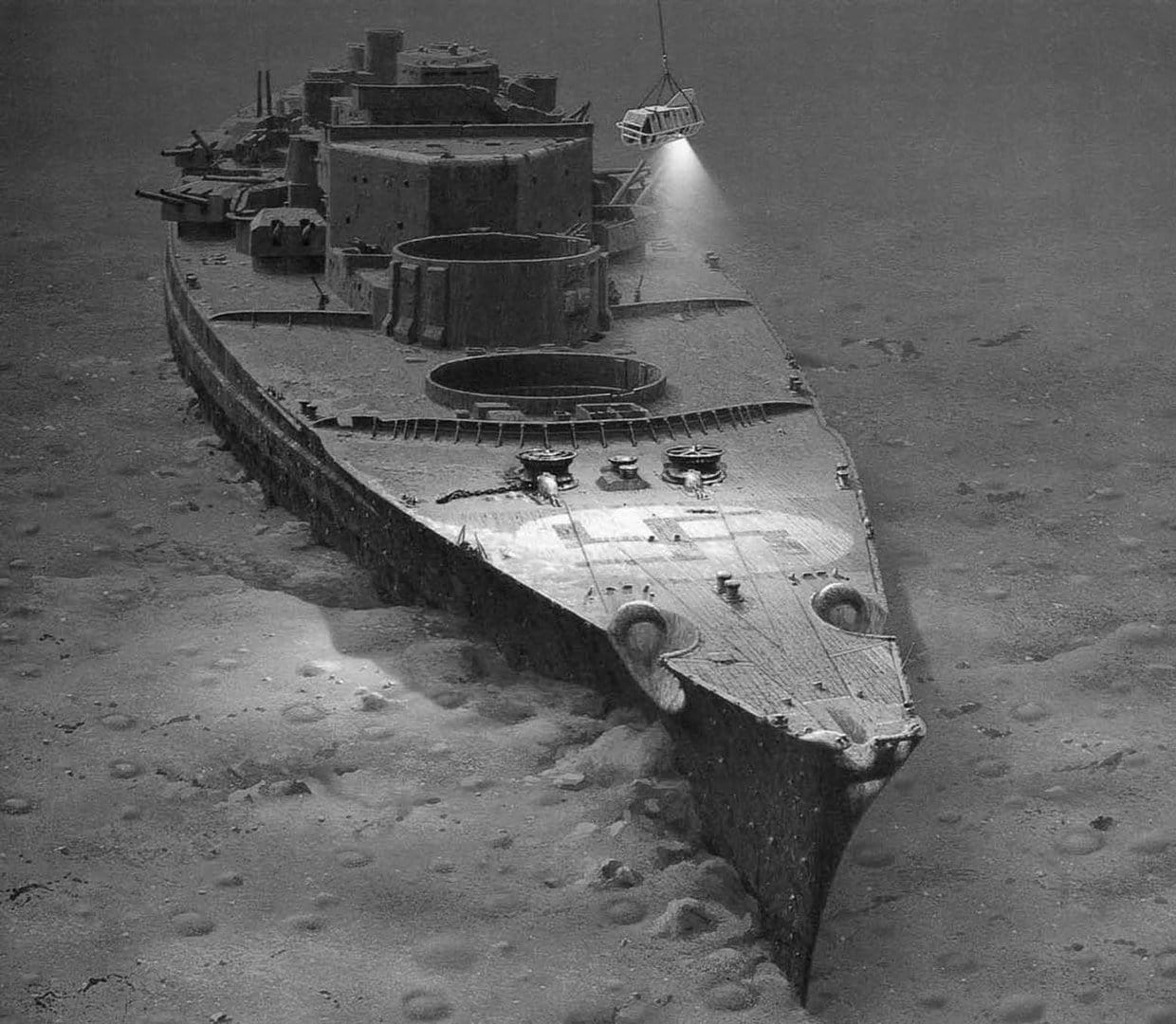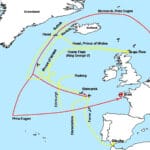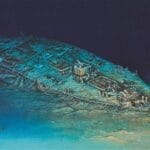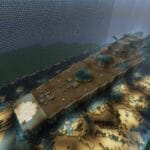Ready to delve into the depths of the Atlantic and uncover the fascinating Bismarck shipwreck? This colossal vessel, bigger than the Titanic, sailed as a symbol of Nazi Germany’s naval might. In 1941, during World War II, it faced a historic battle with the British Royal Navy. Join us on a journey to explore the Bismarck’s legacy, uncover its secrets, and honor those who sailed aboard this legendary warship.
Bismarck: Ghost Ship of the Atlantic
Two miles below the surface of the North Atlantic, shrouded in darkness and silence, rests the wreck of the Bismarck. This wasn’t just any ship; the Bismarck was a behemoth, the pride of the German navy during World War II. Today, it stands as a solemn reminder of the sheer power of the ocean and the devastating consequences of war.
The Bismarck was launched in 1939, a symbol of Germany’s growing military might. Imagine a ship the length of two and a half football fields, bristling with huge guns and armored like a fortress – that was the Bismarck. Her mission: to rule the Atlantic and cripple Allied supply lines.
In May 1941, the Bismarck set sail on her first and final mission. It didn’t take long for her to make her presence felt. She engaged and sank the British battlecruiser HMS Hood, a devastating blow that sent shockwaves through the British Admiralty. The hunt for the Bismarck was on.
The Hunt and Final Fate of a Leviathan
The British were relentless, throwing everything they had at the German behemoth. Finally, they caught up with her. Crippled by relentless attacks, the Bismarck, once deemed unsinkable, met her demise on May 26th, 1941. Over two thousand German sailors perished in the frigid waters, their final resting place becoming the ship they served.
For years, the Bismarck’s final resting place remained a mystery. Then, in 1989, a team led by renowned oceanographer Dr. Robert Ballard, the man who discovered the Titanic, located the wreck. There she was, sitting upright on the seabed, a ghost ship frozen in time.
The Bismarck’s discovery wasn’t just a historical footnote. It provided invaluable insights into the final moments of the legendary ship and the battle that sealed her fate. Today, the wreck is a protected war grave, a reminder of the human cost of conflict and the thousands of sailors who lost their lives in the icy depths.
Though the Bismarck’s story ended in tragedy, her submerged hulk continues to fascinate and intrigue. Studying the wreck allows us to piece together the events of that fateful battle and gain a deeper understanding of naval warfare during the war. The Bismarck serves as a reminder that even the mightiest creations can be brought down, swallowed by the sea, leaving behind only echoes of their former glory.
Bismarck’s Location: Unveiling the Deep
You bet the wreck of the Bismarck has been found! The German battleship Bismarck was a fearsome symbol of Nazi naval power during World War II. After a dramatic chase and battle, it was sunk by the British Royal Navy in May 1941. For years, the exact location where this mighty warship came to rest was a mystery.
It wasn’t until 1989, more than forty years after its sinking, that the wreck of the Bismarck was discovered. A team led by the famous oceanographer, Dr. Robert Ballard, used advanced sonar technology and a remotely operated vehicle (ROV) to locate the ship.
They found it standing upright on the ocean floor, about 470 miles west of Brest, France, at a depth of almost 3 miles! Finding the Bismarck in such good condition, even after all those years at the bottom of the Atlantic, was incredible.
A Time Capsule of War
The discovery of the Bismarck was a major event, but it only deepened the mysteries surrounding this legendary ship. Some believe the ship sank due to sabotage from its own crew, while others argue it was solely the relentless British attack that caused its demise. The exact circumstances surrounding the final moments of the Bismarck and its crew continue to be debated to this day.
Deeper Than the Titanic: Comparing Ocean Depths
So, we know where these giants of the sea met their end, but how do their resting places compare in terms of depth? Well, it turns out that the Bismarck went down much deeper than the Titanic.
Imagine the Titanic resting on the ocean floor at a depth of about 12,500 feet – that’s already incredibly deep. Now, picture the Bismarck sinking even further, coming to rest at a staggering depth of 15,719 feet. That’s a difference of over 3,200 feet, which is almost like stacking another Empire State Building on top of the Titanic!
This extreme depth is likely a big part of the reason why the Bismarck is surprisingly well-preserved. It’s as if the ocean decided to tuck it away in a quiet corner where the usual wear and tear of the deep sea isn’t as harsh.
Exploring the Abyss: Challenges and Rewards
Exploring the Bismarck at that depth is no walk in the park. It takes serious technology and a whole lot of expertise to get down there. But the challenges are worth it because these wrecks aren’t just piles of metal. They’re like time capsules, giving us glimpses into history and reminding us of the power of nature. Both the Titanic and the Bismarck serve as underwater memorials, each with a story to tell about the people who sailed on them and the events that shaped our world.
The Sinking of Bismarck: A Mystery of Conflicting Accounts
The Bismarck, that mighty beast of the German navy, met its end on May 27th, 1941. But the details surrounding its demise, particularly the question of who delivered the final blow, have been a source of debate and speculation ever since.
While it’s clear that the British Royal Navy played a significant role in the Bismarck’s sinking, there’s compelling evidence suggesting the ship’s own crew might have had a hand in its final moments.
A Battle for the Ages
The Battle of the Denmark Strait saw the Bismarck face off against a relentless British assault. First, it tangled with the battlecruisers HMS Hood and HMS Prince of Wales, sending the Hood to a watery grave with astonishing speed. Then, torpedo bombers from the HMS Victorious swooped in, their relentless attacks crippling the Bismarck’s steering and leaving it vulnerable. The final act saw British battleships, the HMS King George V and HMS Rodney, deliver a relentless barrage, pounding the Bismarck until it was nothing but a burning wreck.
Yet, amidst the chaos of that naval battle, a mystery emerged. Erich Bey, the First Officer on the Prinz Eugen, which was with the Bismarck, swore he saw scuttling charges go off on the Bismarck before it vanished beneath the waves. His account aligns with the stories of some German survivors who claim they heard not one, but two distinct explosions just before the ship went down. The plot thickens when other survivors only recall a single, deafening blast.
Unanswered Questions Linger
Adding to the enigma, we may never know the exact number of souls lost that day. Estimates range from 2,066 to 2,302, a grim testament to the fog of war and the enduring mysteries it leaves in its wake.
So, who really sank the Bismarck? Was it the unrelenting firepower of the British, or did the proud German crew choose to send their ship to its grave rather than see it fall into enemy hands? The answer, shrouded in the mists of time and conflicting accounts, remains a subject of historical debate. What we do know is that the Bismarck’s sinking stands as a testament to the brutal realities of war, a stark reminder of the courage, sacrifice, and enduring mysteries that define those tumultuous times.
A Captain’s Decision: Scuttling the Bismarck?
The last moments of the mighty Bismarck, a formidable German battleship, weren’t those of a warrior falling in the heat of battle. Instead, they were shrouded in a mystery that persists to this day. Did the Bismarck’s crew make the heartbreaking decision to send their own ship to the bottom of the ocean, or were they simply overwhelmed by the relentless assault of the British navy?
On May 27th, 1941, the Bismarck found itself facing a seemingly endless barrage of torpedoes and shells unleashed by British warships, the King George V and the Rodney. Heavily damaged and taking on water rapidly, the once mighty ship was clearly in its death throes. It was then that Captain Lindemann may have issued the fateful order to scuttle the Bismarck, denying the British a prize and sparing his crew from the humiliation of capture.
Two Sides to Every Story
However, the British tell a different tale. They maintain that it was their relentless attack, a display of raw naval power, that sent the Bismarck to a watery grave. The sheer volume of fire they poured into the German ship, coupled with the speed at which she sank, seems to bolster their version of events.
Years later, in 1989, renowned deep-sea explorer Dr. Robert Ballard, famous for discovering the wreck of the Titanic, provided a new piece of the puzzle. His exploration of the Bismarck’s wreck revealed open seacocks – valves that controlled the flow of seawater into the hull. This finding strongly suggests a deliberate attempt to flood and sink the ship.
Unraveling the Evidence
But the riddle of the Bismarck’s demise doesn’t end there. Ballard’s investigation also revealed the extensive damage inflicted by the British bombardment, leaving many unconvinced that scuttling alone could have accounted for such a rapid sinking.
This debate is far from over. Those who support the scuttling theory often point to eyewitness accounts from surviving German sailors and the compelling evidence of the open seacocks. On the other side, proponents of the British attack theory highlight the undeniable damage inflicted on the Bismarck and the sheer ferocity of their assault.
So, what really happened on that fateful day? The Bismarck’s final moments remain a subject of debate, a puzzle with perhaps more than one answer. Did the pride of the German navy succumb to a relentless enemy or did her loyal crew choose to send her beneath the waves rather than see her fall into enemy hands? The evidence is compelling on both sides, ensuring that the mystery of the Bismarck will continue to fascinate and intrigue us for years to come.
Key Points:
- The Bismarck, a massive German battleship, was launched in 1939.
- Sinking the British battlecruiser HMS Hood in 1941, the Bismarck posed a significant threat to Allied supply lines.
- A relentless British pursuit resulted in the Bismarck’s destruction on May 26, 1941, with over 2,000 German sailors perishing.
- The Bismarck’s wreck was discovered in 1989 by Dr. Robert Ballard’s team.
- The wreck lies upright on the seabed, providing insights into the final moments of the ship and the battle.
- The Bismarck is now a protected war grave, honoring the fallen sailors.
- Studying the wreck enhances our understanding of naval warfare during World War II.
- Despite its former glory, the Bismarck’s hulk serves as a reminder of the fragility of even the most powerful vessels in the face of the unforgiving ocean.
The wreck of the battleship Bismarck is one of the most famous shipwrecks in history. Big Bird on the Challenger was a popular children’s television character who appeared on the Space Shuttle Challenger in 1985. Bonnie and Clyde’s funeral was a major media event, with thousands of people attending. The bed of Catherine the Great is a magnificent piece of furniture that was once owned by the Russian empress.
- Unveiling Bernhard Caesar Einstein’s Scientific Achievements: A Legacy in Engineering - July 15, 2025
- Uncover who is Jerry McSorley: CEO, Family Man, Business Success Story - July 15, 2025
- Discover Bernhard Caesar Einstein’s Scientific Contributions: Unveiling a Legacy Beyond Einstein - July 15, 2025















